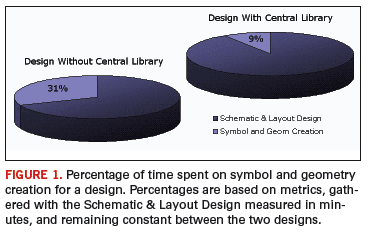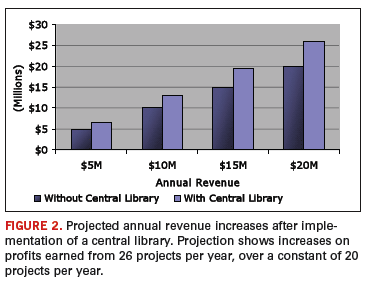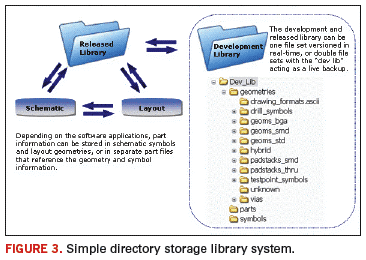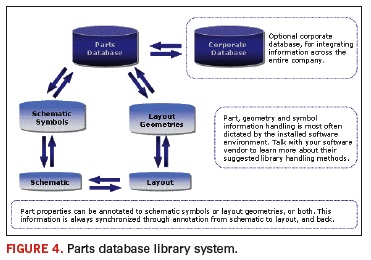The PCB Design Library

Building and managing a library can translate into long-term timesavings and improved margins.
From schematic capture to layout to manufacturing, no company can hope to create any kind of monetary efficiency without first planning, building and maintaining a parts and symbols library. Among the large corporations, it is well understood that cutting a few minutes from a design flow means massive increases in profit margins. But smaller companies sometimes do not see the same picture. The result of not having this one tool at the users’ disposal is virtual mayhem when it comes to meeting deadlines and ultimately to making profits on the designs sent to manufacturing.
A good way to look at this is through a simple time chart that breaks up the amount of time spent designing, versus the amount of time performing repetitive drafting tasks such as building symbols and geometries for a schematic and layout. To better study this, I utilized a small schematic and layout design that already existed and set to the task of recreating the symbols. In the first design, I created a handful of symbols and parts from scratch while copying in the rest to mimic a realistic scenario within a company that has no library. Most often, designers in these environments copy symbols, parts and geometries from old designs and then build the missing symbols and parts. In the second design, I pulled in the missing handful of parts and symbols from a library. The results of my time usage are shown in Figure 1.

While the results aren’t exactly surprising, it does help give us realistic numbers to show just how much time can be saved. This was a very small project for the purpose of gathering metrics data, but the process of pulling symbols and geometries from a library shaved a full hour from the design time. This time savings could be exponentially greater for a larger design with a more complex set of symbols and geometries, which would free up design teams to take on more projects or to spend more time on research and development.
Along with timesavings, this more streamlined environment can directly affect the revenue stream for a small- to medium-sized company or within the design division of a larger company. For instance, if a division or company is spending 31% of its design time building missing geometries and symbols, and it generally completes 20 projects per year, the same company could be completing 26 projects per year. Along with faster time-to-market, this small increase in projects can increase annual revenue by millions of dollars (Figure 2).

While designers and managers generally agree that a centralized library would help streamline the design flow, this suggestion is often met with a loud groan at the thought of having to set aside time and resources to create the library. These statistics should serve as an adequate motivation to illustrate that it’s time to get moving. The initial headaches of time and resource investment are far outweighed by the positive gains in both daily work lives for designers and revenue stream for the entire company.
Choosing a Library Format: Database or No Database?
Library structures come in all flavors, and finding the best configuration for a company depends on many factors. But before examining these factors, it is important to remind ourselves of the simplicity of the concept: a library is a centralized location where information is available to users for the purpose of unifying and simplifying the design process. The library itself doesn’t have to be a complex web of information if the company environment doesn’t call for that.
In the simplest version, a flat file directory structure can be more than enough for a smaller design group. This library would be a simple file and directory organization with the library name at the top of the directory structure, with symbols and geometries underneath and subfolders of appropriate categorizations beneath the symbol and geometry folders (Figure 3). When libraries are especially small, users can even read the entire library into each new schematic and layout and use whatever is needed, but in the more typical scenario, users would only bring in whatever symbols and geometries are needed for that specific design.

At the minimum, even small companies are going to have libraries that are sizable enough to require an organized directory structure. How the directories and subdirectories are organized should be carefully decided based on the frequency that groups of symbols and geometries are used. For example, separating through-hole and surface mount geometries from one another usually helps layout designers locate exactly what they need quickly. This library structure should be considered adequate in smaller environments where the parts’ information tends to remain relatively static.
For environments where parts information is constantly updated or changed according to availability and cost, there are many options for structures that utilize a parts database system to make it easier to maintain more rapidly changing information. A parts database system is useful for medium to large design teams, both for its faster performance for designers searching for part information and because it is easier to maintain from a librarian or corporate level. To see an overview concept of a database library system, see Figure 4.

It should be noted that once a library system reaches the complexity of a database of parts that are complemented with graphic symbols and geometries for placement into the schematic and layout, chances are that this system will require at least one full-time librarian to manage the information.
Library Maintenance Issues to Consider: Who Does It, and How?
Once the file format of the library is tentatively decided, it is important to think through the maintenance processes. In a small team environment, it could be a group effort with one principal designer in charge of making sure no one introduces errors into the library. Or, one engineer could monitor the schematic information while one layout designer monitors the geometry information. In a medium to large design group, it is a good idea to hire at least one full- or part-time librarian to maintain all the information separately from the design groups. This helps prevent confusion that can occur from the number of people sharing information. In librarian-managed environments, designers are not allowed to put any new information into a library; they must request that the librarian add whatever is missing.
The larger design groups tend to have two to three librarians. Typically, one librarian will manage the parts database information, and one or more librarians will manage the graphical symbol and geometry information. The reason this can become such a big job is because all of this information must be correct. For example, if a schematic symbol’s pin names and numbers do not directly correspond to its associated layout geometry, the layout designer will have no idea which signals are meant for which pins. In higher-level design systems, it is not even possible to place geometries that don’t have matching schematic pin and gate information. Given that this level of detail and verification is required to keep a library in order, it is easy to see why companies hire librarians to focus on the task, allowing designers to focus on the designs. The margin for error is greatly reduced if this division of labor is put in place from the beginning.
The way in which the library’s versioning is structured can be influenced by who maintains it–librarians or designers. All library systems have versioning of some kind such as libraries, parts, symbols and geometry information. This is usually accomplished with direct file versioning systems, but it can also be accomplished through manually maintained copies. Before putting a library into motion, decide whether there will be only one library accessed by librarians and designers at the same time and backed up daily, or whether there will be a “release library” available to designers with incremental updates made by the librarians’ “development library,” either daily or weekly. Many larger companies have incremental, automated updating systems that run on a nightly basis while no one is attempting to access information. Note that all of these options apply to flat file or database systems, so it is important to consider how data collisions may or may not occur in a specific design environment.
Along with formatting and versioning considerations, another maintenance issue that often causes frustration for designers and librarians alike is how new part requests should be handled. When embarking on a new project, designers often need parts that are not found in the library. In loose library environments, designers can build their own part, symbol and geometry information and upload it to the main library for others to use. But as design teams get larger, this becomes an error-prone area that can cause designs to fail if a bad part is shared among many projects. In this environment, it becomes imperative not to allow designers to upload new information, but rather to have a librarian approve any new parts, symbols or geometries and publish them for general use. In this scenario, designers can request a new part and wait for the librarian, or they can make their request and then place a “dummy” symbol or geometry while they wait to get the approved symbol or geometry from the librarian.
Using a “dummy” system places a shared responsibility on both designer and librarian and allows everyone to progress without having to wait for one another. The engineer or the designer may take a best guess when building the library symbol or geometry based on the established part information included. This “dummy” is then presented to the librarian, in full or partial form. While the engineer or designer continues on with his work, the librarian makes any adjustments necessary and publishes the approved part back to the main library. The engineer or designer can then replace any “dummy” information with the fully approved symbol or geometry information.
While it is a proven fact that utilizing a central library will save design time, user confusion from not understanding how the library is intended to be managed can narrow the time savings window to the point that it no longer benefits the company. Not only is management of file and database information crucial, it is also of utmost importance to manage expectations and usage of that information.
Rogue designers and engineers can tear apart a carefully planned library system in no time if they are not brought around to seeing the advantages of following the rules. The onus is placed on the managers and librarians to provide clear guidelines to maintain order among design teams. But there is no hard line in the sand; a library is a team effort to maintain, and it is entirely possible that the decisions made from the beginning may need to be reconsidered and tweaked once the library is put into action.
A library is not simply a tool; it is a small building block on which a company can expand its success and profit. PCD&F
Abby Monaco is product manager with Intercept Technology Inc. and can be reached at This email address is being protected from spambots. You need JavaScript enabled to view it..




